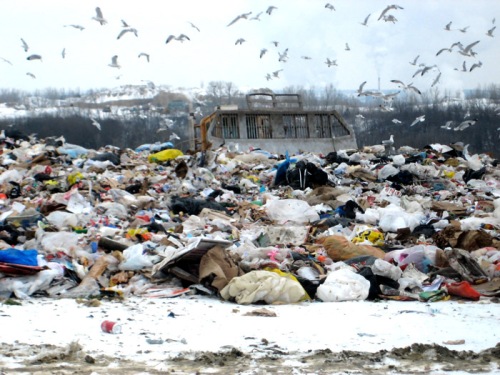The four Rs (reduce, reuse, recycle, remember this phrase for the rest of eternity) have been drilled into our heads, and it seems Lawrencians are finally learning that one man’s trash is another man’s recycling.
When throwing something away, most people do not usually think about the final destination. Where exactly is “away”?
For most of northeast Kansas, “away” is about 10 miles north of Lawrence, just past the Jefferson County line. Tucked away on 360 acres behind limestone quarries and rows of trees is the Hamm landfill, the final resting place of the University’s trash.
Charlie Sedlock, division manager for Hamm Waste Services, estimates that KU Facilities Operations hauls in about 40 tons per month. He says this number changes seasonally, but this averages out to about 3 pounds of trash per student every month.
Current statistics show that an average American produces a little more than 7 pounds of trash every week.
How could it be that the average American generates a pound of trash daily, but KU students are only producing one-tenth of that?
Enter the ubiquitous blue recycling bins that litter campus.
Sedlock says the amount of trash generated per person has decreased because of recycling. Even though the landfill serves more customers, Sedlock says the amount of waste coming in has plateaued during the last five years.
Even as a waste company, Sedlock says Hamm Waste Services has a vested interest in seeing cost-effective and well reasoned recycling programs succeed.
“Disposal is the cheapest option, but not necessarily the only option,” he says. “It’s more of a philosophical question. If the citizenry that our clients are serving want some sort of recycling program and our client is able to do that in a cost-effective manner, we think it’s a win-win situation. If they aren’t serving their citizens, then multi-national corporations can come in and take control.”
Although many picture the surface of the landfill as a liquefied mess of diapers and yard clippings, the ground is actually hard, and the landfill appears to be filled with discarded paper products. Sedlock says the largest percentage of waste coming in is paper products, such as cardboard.
All paper products can be recycled, and the City of Lawrence is doing a better job of advertising this, but Sedlock says that by the time they get to the landfill, they are beyond being returned to the blue bins.
“It’s not an environment for recycling by the time it gets here,” Sedlock says.
When trash is dumped, the pressure that accumulates from the weight of the trash above does not allow it to break down and biodegrade.
“It becomes mummified trash,” Sedlock says. “I can show you a banana peel from the day you were born or a yellowed newspaper from 1984.”
According to the Environmental Protection Agency, landfills are the No. 1 source of methane, a greenhouse gas that is 23 times more potent than carbon dioxide. Sedlock says waste produces a mixture of gases for about 20 years after it is discarded, peaking like a bell curve in the middle of the life cycle.
He says a fair share of gas passively vents from the landfill, but it is required to meet regulatory EPA thresholds.
However, a promising aspect of methane is the fact that it is one of the few greenhouse gases that can be harnessed to create energy.
Sedlock says Hamm Waste Services will look into converting emitted methane into energy, but the current system lacks a way to transport that energy.
It seems like Lawrence has overcome the hurdle of creating an effective recycling program, but it was disheartening to see that the majority of the waste in the landfill could have been recycled. Residents in the northeastern part of the state have obviously decreased the flow of waste going into the landfill, but the city and the University should look into mandatory recycling programs that would cut this back even more.
We can’t trash-talk recycling any longer. With recycling bins and other trash alternatives available nearly everywhere, there’s no excuse not to clean up your act.
— originally published in Jayplay magazine on Feb. 28, 2008 (PDF). Click here for its original online home.

